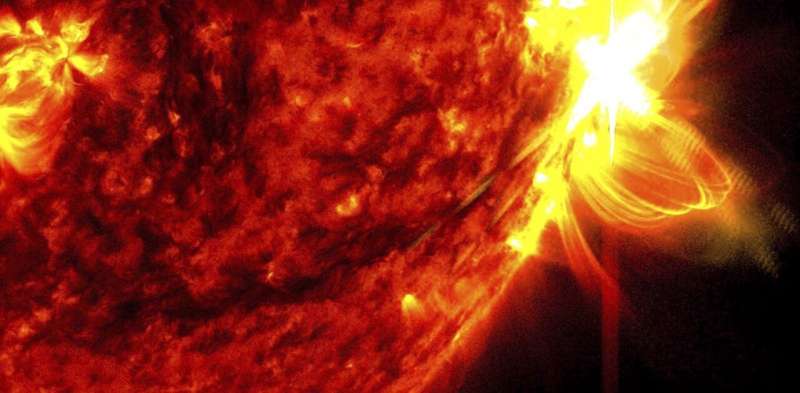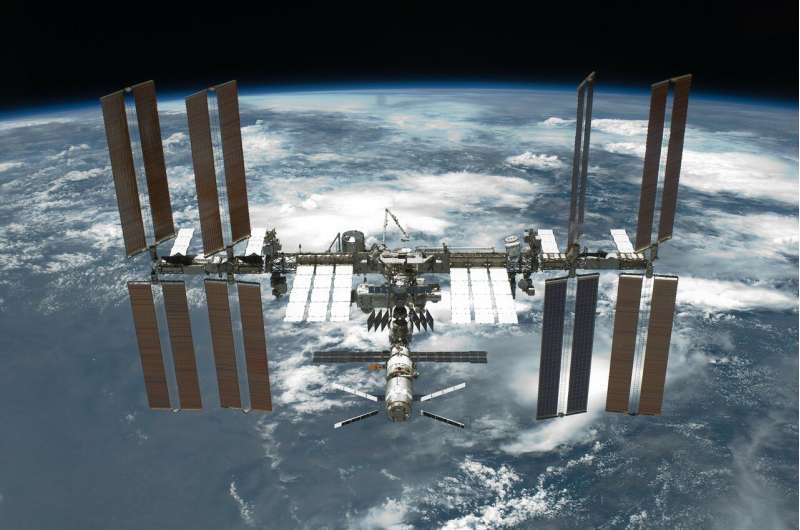Virgin Galactic announces reverse stock split to boost share price
Thursday, 13 June 2024 16:04

Space weather forecasting needs an upgrade to protect future Artemis astronauts
Thursday, 13 June 2024 13:18
NASA has set its sights on the moon, aiming to send astronauts back to the lunar surface by 2026 and establish a long-term presence there by the 2030s. But the moon isn't exactly a habitable place for people.
Cosmic rays from distant stars and galaxies and solar energetic particles from the sun bombard the surface, and exposure to these particles can pose a risk to human health.
Both galactic cosmic rays and solar energetic particles, are high-energy particles that travel close to the speed of light.
While galactic cosmic radiation trickles toward the moon in a relatively steady stream, energetic particles can come from the sun in big bursts. These particles can penetrate human flesh and increase the risk of cancer.
Earth has a magnetic field that provides a shield against high-energy particles from space. But the moon doesn't have a magnetic field, leaving its surface vulnerable to bombardment by these particles.
LeoLabs wins AFWERX contract to develop next-generation radar
Thursday, 13 June 2024 12:00

China’s secretive spaceplane conducts proximity operations with small spacecraft
Thursday, 13 June 2024 11:15
Hera and its CubeSats speak with mission control
Thursday, 13 June 2024 10:55
ESA’s Hera asteroid mission and its two CubeSats interacted as if they were in space, within the foam pyramid-lined walls of the Agency’s Maxwell test chamber in the Netherlands. The trio communicated together, sharing data and ranging information at the same time as their Hera mothership received commands from its mission controllers at the European Space Operations Centre in Darmstadt, Germany.
ESA prepares for its first open day in the UK
Thursday, 13 June 2024 10:40
ESA is getting ready to show thousands of visitors how space improves life on Earth at its very first open day to be held in the UK.
Astronauts set for spacewalk: Starliner crew staying at ISS longer
Thursday, 13 June 2024 10:10
A pair of NASA astronauts are scheduled to do a 6.5 hour spacewalk on the morning of June 13 outside the International Space Station.
At 8 a.m. Eastern time, astronauts Tracy C. Dyson and Matthew Dominick are expected to enter the vacuum of space to perform station maintenance and science work.
NASA said the two will remove some communications equipment from one of the ISS' laboratory modules, getting help from a robotic arm on the station. Astronauts Mike Barratt and Jeanette Epps will be maneuvering the Canadarm2 to assist Dyson and Dominick in their work.
Then, Dyson and Dominick will move on to a science experiment involving microorganisms. They will swab surfaces on the ISS to "determine if microorganisms released through station vents can survive the external microgravity environment," NASA said in a statement.
NASA TV will begin its spacewalk broadcast at 6:30 a.m. Thursday. Live coverage will air on NASA+, NASA Television, the NASA app, YouTube, and the agency's website.
Among those watching the spacewalk up close will be Butch Whitmore and Suni Williams, the crew of the Boeing Starliner which launched from the Kennedy Space Center on June 5 en route to the ISS.
Hughes Europe Enters Defense and Government Markets with Konnect VHTS Services
Thursday, 13 June 2024 08:30 Hughes Europe, a subsidiary of Hughes Network Systems, LLC, an EchoStar company (Nasdaq: SATS), announces its strategic expansion into the military, defense, and government sectors across pan-European nations. Troy Truman has joined Hughes and will act as the head of this initiative.
The initiative will meet the increasing demand for high-speed connectivity and the growing security concern
Hughes Europe, a subsidiary of Hughes Network Systems, LLC, an EchoStar company (Nasdaq: SATS), announces its strategic expansion into the military, defense, and government sectors across pan-European nations. Troy Truman has joined Hughes and will act as the head of this initiative.
The initiative will meet the increasing demand for high-speed connectivity and the growing security concern NASA Selects Proposals for Space Weather Study
Thursday, 13 June 2024 08:30 NASA has selected three proposals for concept studies of missions to investigate the complex system of space weather that surrounds our planet and its connection to Earth's atmosphere.
The three concepts propose how to implement the DYNAMIC (Dynamical Neutral Atmosphere-Ionosphere Coupling) mission, recommended by the 2013 Decadal Survey for Solar and Space Physics. The DYNAMIC mission aim
NASA has selected three proposals for concept studies of missions to investigate the complex system of space weather that surrounds our planet and its connection to Earth's atmosphere.
The three concepts propose how to implement the DYNAMIC (Dynamical Neutral Atmosphere-Ionosphere Coupling) mission, recommended by the 2013 Decadal Survey for Solar and Space Physics. The DYNAMIC mission aim First Camera Integrated for Plato Exoplanet Explorer
Thursday, 13 June 2024 08:30 The integration of Plato's cameras has commenced at OHB's Space Centre and Optics facility in Oberpfaffenhofen, Germany. The first of 26 cameras has been successfully attached to Plato's optical bench, ensuring precise alignment for the mission.
"Plato will use 24 'normal' cameras and 2 'fast' cameras to look at more than 100 000 stars and search for planets around them." The mission uses
The integration of Plato's cameras has commenced at OHB's Space Centre and Optics facility in Oberpfaffenhofen, Germany. The first of 26 cameras has been successfully attached to Plato's optical bench, ensuring precise alignment for the mission.
"Plato will use 24 'normal' cameras and 2 'fast' cameras to look at more than 100 000 stars and search for planets around them." The mission uses Thales, Spire and ESSP to develop air traffic surveillance constellation
Thursday, 13 June 2024 07:00









